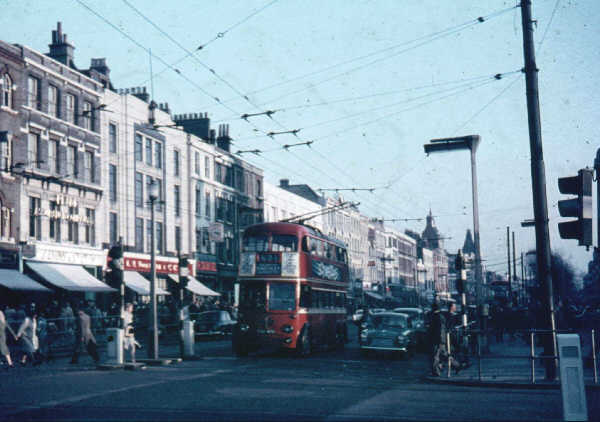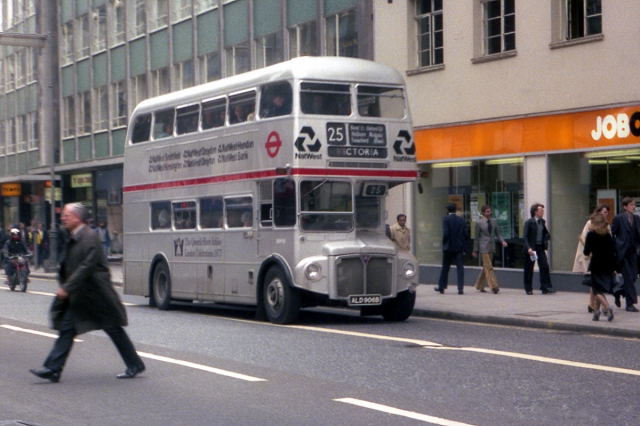Today, a day that will live in infamy, the last proper red London bus will complete a schedule route. Born in 1954, the first four prototypes had 2872 offspring in a number of variations. A very few will linger on serving “heritage” routes, mere stumps of the full ones. Others are in private hand or have been decapitated to serve a tourist buses. Its pale imitators will shudder and jerk along the streets but in truth the last real red London bus will die today. Killed off by regulation and, I am afraid, stupid Americans.

The original design was to replace “trolleybuses” which were being phased out. Powered by electricity from overhead cables, they differed from trams by having both the connections overhead and had ordinary pneumatic tyres rather than metal ones running in tracks. Routemasters were the last bus to be designed entirely by London Transport. Because of this they are highly suited to the road conditions and the constant stop-start at lights and close stops. They have dedicated supporters and fans, many of who aspire to own one. A brief account of its birth and development
Although the Routemaster was designed in the 1950’s, one should not forget what an advanced design it was for its time. By using a light alloy body, it was possible to produce a 64-seat bus within the weight limits of the older 56-seat RT bus. The RM also differed from earlier London designs in being of integral construction. Instead of having a traditional body and chassis, the Routemaster has a strengthened body which does not require a chassis to take the stress. The mechanical units are mounted on front and rear sub-frames rather than a heavy fixed chassis. Other novel features for a bus of the 1950’s, but fitted as standard to the Routemaster, included independent front suspension, power steering, fully automatic gearbox and power-hydraulic braking. In 1961, 24 vehicles were built and then lengthened by the insertion of an additional 2ft 6in bay in the centre of their bodywork. Classified RML, this version with its 72-seat bodywork became the standard product from 1965 and remains the most common type in London today. At approximately 7 3/4 tons, the RML is still some 2 tons lighter than modern double deck vehicles of similar passenger capacity.
A trolleybus the RM was designed to replace.

An older RT bus – immediately identifiable as such by the radiator shape.

The classic RM that superceeed it. This one in the special silver livery to mark the Queen’s silver Jubilee.

There were diffent variations on the basic theme. As well as the RM and longer RML, some had electrically operated rear doors instead of the classic open platform that allows you to “hop on, hop off” at lights or in heavy traffic. They were often used on the long distance “Green Line” service which had limited stops and routes extending into the countryside. They were designated with a “C” for coach, the shorter being RMC and the larger capacity ones RCL. Further variations included special ones with trailers to serve the airport and a number for another bus operator.
One prototype front-entry routemaster was produced to show the flexibility of the basic design could meet the demands for “one person operation” where the driver also collects the fare. It survives in a museum and gets the occasional outing

Here it is alongside a classic central London version for comparison

And here with one in the Green Line colors

Privatisation of the London Buses mean that they passed on to new companies. To save on staff many of these replaced them with a variety of buses purchased off the shelf from manufacturers from all over Europe. These featured front entry, side exit door – a safety requirement – with the driver collecting fares and issuing tickets. The routemasters had a conductor who ensured safety by controlling numbers to avoid overcrowding and clear the platform. They collected fares and issued tickets so in central London the routemasters were very much more efficient as they needed less time at the stops. This problem has been solved by requiring people to buy tickets before boarding a bus in central London. The “Oyster cards” can either be pre-loaded with cash or a season ticket. With radio frequency readers on the bus they are simply held to a plate to recognise the term ticket or deduct the fare. The new high capacity single decked “bendy buses” have multiple entries and readers throughout the bus.
The cost of keeping the aging stock on the road and insurance claims from tourists falling when clumsily alighting or trying to get on as lights changed, meant most had to go. Aside from those limited few, a design icon, that was so well built it gave twice or three times its planned working life, will go from the streets of London. Many of the bodies will be cherished and preserved.
The future for London buses will almost go back to the start of the routemaster story. Some areas like Croydon are seeing the return of trams, which the trollybuses replaced. Now experimental fuel cell buses are being trialled.





